An expansion gap is an integral part of fitting your bamboo floor. Any professional floor fitter will know why and how you need to leave the gap. It simply allows your bamboo floor to expand, contract and move naturally with changes in the atmosphere.
If you do not leave an expansion gap, your bamboo floor can start to crack and lift. This is because there will be no room for the planks to naturally expand into. The way the bamboo will expand and contract is a very standard process. As it is a natural product, it will adapt to changes in its surroundings. When the room becomes warm or humid, the bamboo will absorb some of the moisture in the air, and naturally expand. A sufficient expansion gap will allow room for this process to occur.
What is an expansion gap?
An expansion gap is a gap of at least 10mm, which needs to be left around the edge of the room when installing your floor. This gap must be left around the whole perimeter of the room where the floor comes into contact with any fixed objects such as walls, fireplaces, door frames, and any pipework.

How can I cover up the gap?
We have a range of different bamboo flooring profiles that will enable you to cover over your gap. To cover an expansion gap around the edge of your room, you will either want to use bamboo skirting.
Alternatively, if you already have existing skirting boards you would use bamboo beading. For gaps in doorways, there are a few different options, depending on what type and level of flooring is on the other side of the door.
Have a look at our T-Mouldings, Thresholds, R Profiles and Ramps for more information.
You will be able to find our bamboo flooring profiles to either match or complement your choice and style of bamboo flooring.








